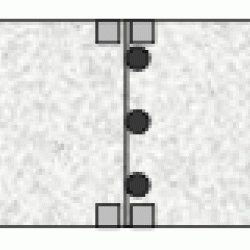Source Institutions
Source Institutions
Add to list Go to activity
Activity link broken? See if it's at the internet archive

Using indirect observational methods, learners distinguish between charged and uncharged objects. This lesson uses magnetic marbles to represent charged particles and iron filings to represent a method of detecting "charged" particles. Use this activity to explain how particle physicists detect and study super small, subatomic particles.
- Under 5 minutes
- 45 to 60 minutes
- $5 - $10 per group of students
- Ages 8 - 14
- Activity, Lesson/Lesson Plan
- English
Quick Guide
Materials List (per group of students)
- Magnetic marbles
- Nonmagnetic marbles
- Iron filings (A cheap source of iron filings are soapless steel wool scrubbing pads, wear gloves when cutting these up.)
- Two stiff surfaces (nonmetallic) about the size of a piece of paper (8.5x11) or larger that can support iron filings and not impede marbles rolling beneath (e.g. cardboard, foam display board, masonite/white board)
- 6 stacks of pennies (14 pennies high) or any objects (2 cm high) to support the stiff surface high enough to allow marbles to roll beneath unimpeded
- Invisible Investigations Student Worksheet
Subjects
-
Mathematics
-
Data Analysis and Probability
- Data Analysis
- Data Collection
-
Data Analysis and Probability
-
Physical Sciences
-
Electricity and Magnetism
- Electric Charges and Currents
- Electromagnetic Fields
- Electric Circuits
-
Structure and Properties of Matter
- Atomic Structure
- Elementary Particles and Nuclear Physics
-
Electricity and Magnetism
-
The Nature of Science
-
The Scientific Process
- Conducting Investigations
- Gathering Data
- Formulating Explanations
- Communicating Results
-
The Scientific Process
Audience
To use this activity, learners need to:
- see
- touch
Learning styles supported:
- Involves hands-on or lab activities
Other
Components that are part of this resource:
Includes alignment to state and/or national standards:
This resource is part of:
Access Rights:
- Free access
By:
Rights:
- All rights reserved, University of Kansas, 2006
Funding Sources:
- University of Kansas
- National Science Foundation, EPS-0236913
- State of Kansas through the Kansas Technology Enterprise Corporation
- National Science Foundation, EPP-0354836
- National Science Foundation, EPS-90903806
- Ewing Marion Kauffman Foundation
